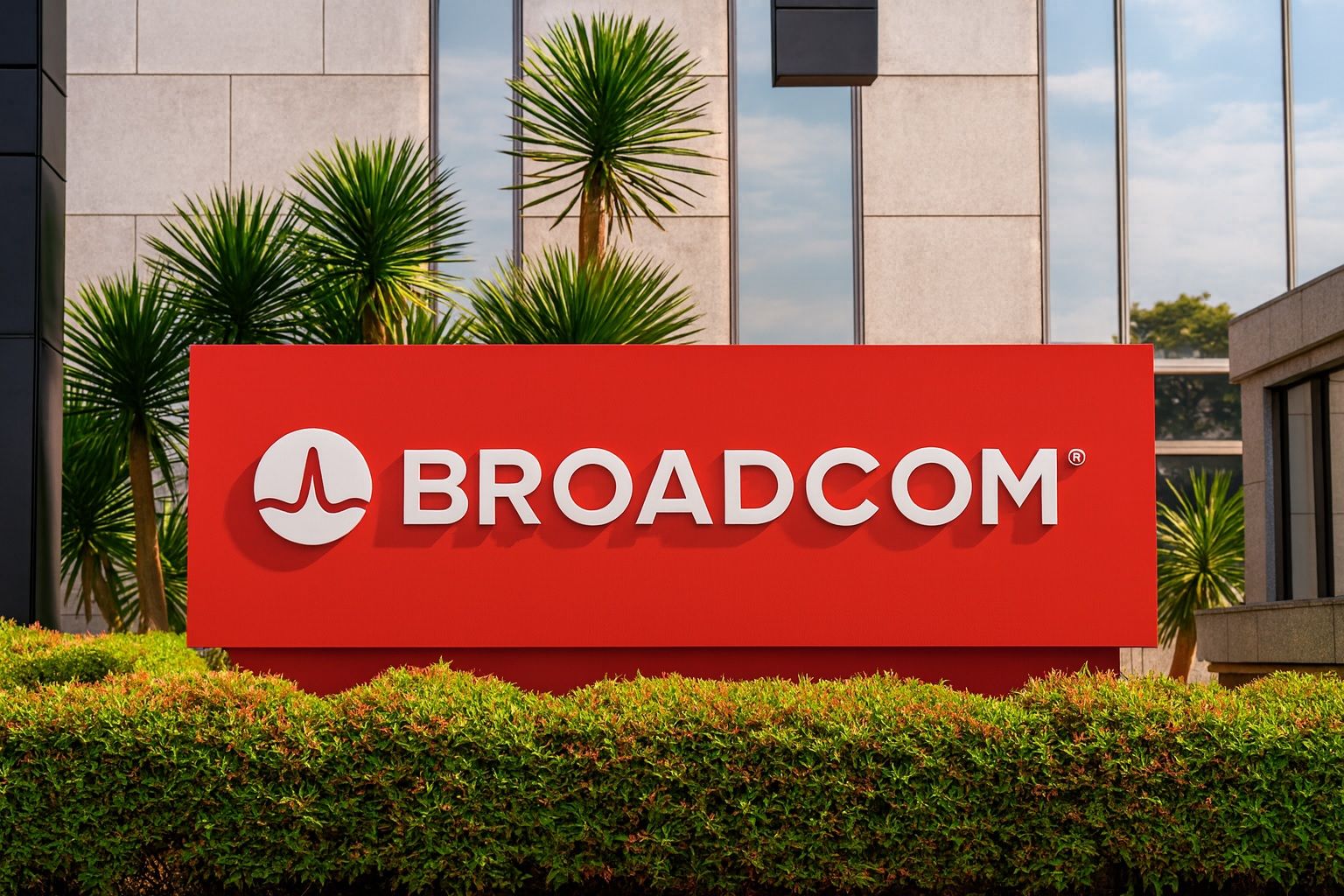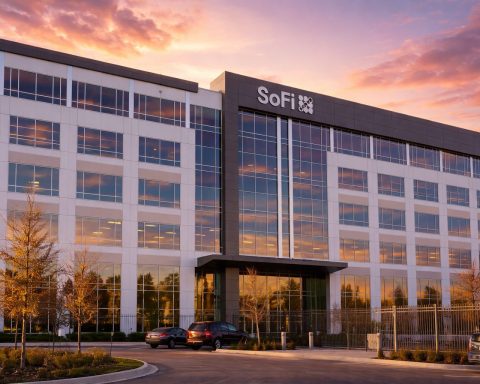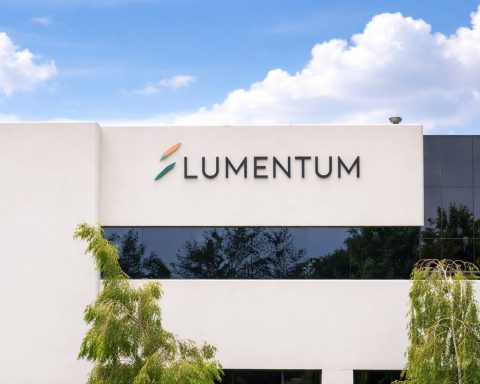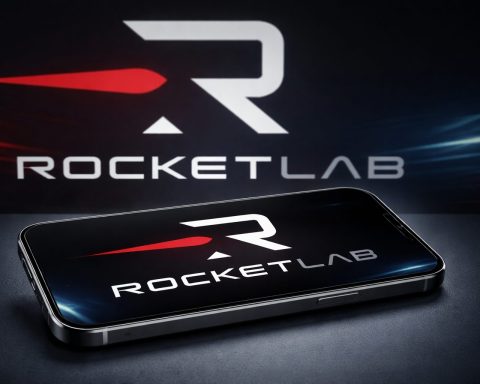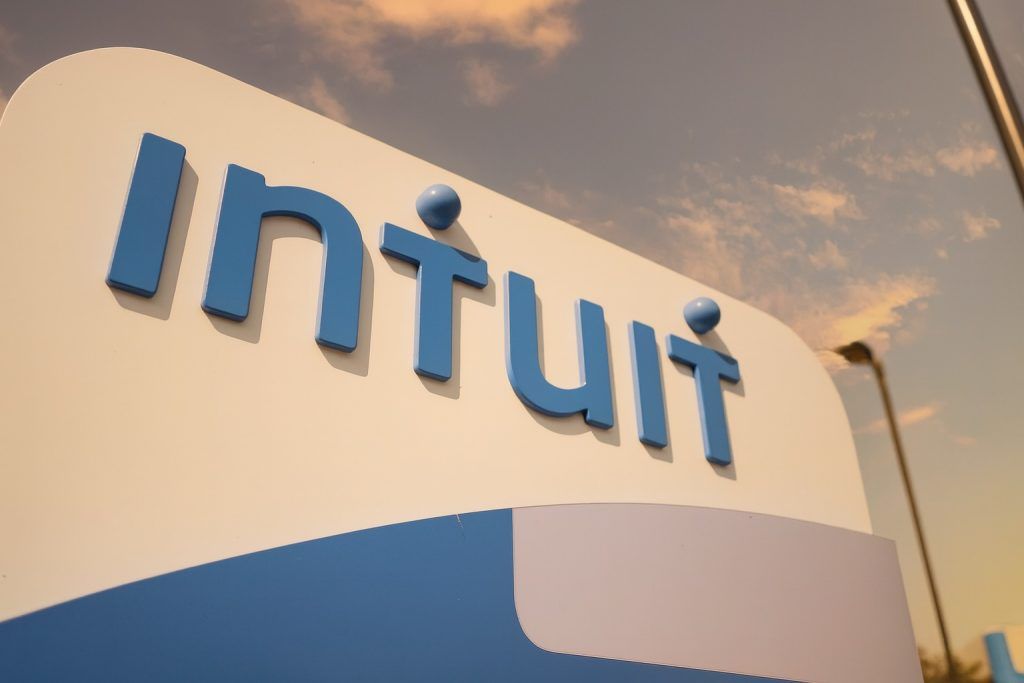Broadcom’s AI Jackpot: Stock Soars on OpenAI Deal as Analysts Bet Big on AVGO
- Stock Price (Oct 19, 2025): Broadcom (NASDAQ: AVGO) is trading around $349 per share (as of last week’s close), after a recent surge fueled by AI news. The stock hit a 52-week high near $374 in early September before a slight pullback [1]. AVGO has rallied roughly +70% year-to-date, more than doubling from about $180 a year ago, vastly outperforming the broader market [2] [3]. On October 13, Broadcom shares jumped ~10% in a single day following major AI partnership news, underscoring investor excitement [4] [5].
- Recent Earnings Strength: Broadcom delivered strong Q3 FY2025 results. Revenue reached $15.95 billion for the quarter (up 22% year-on-year) with Non-GAAP EPS of $1.69 – both beating Wall Street estimates [6]. Management issued bullish guidance for Q4 FY2025, projecting roughly $17.4 billion in revenue (about +24% YoY), ahead of consensus forecasts [7]. CEO Hock Tan credited booming demand for AI chips and networking gear for the growth, while also noting steady gains in Broadcom’s software division (VMware) [8] [9].
- AI Boom and OpenAI Deal: Broadcom’s pivot to artificial intelligence hardware is paying off dramatically. In Q3, AI-related semiconductor revenue surged 63% year-over-year to $5.2 billion [10]. On Oct. 13, 2025, Broadcom and OpenAI announced a landmark collaboration to develop 10 gigawatts of custom AI accelerators (chips) for OpenAI’s future needs [11]. Broadcom will build and deploy these tailor-made AI chips starting in 2026, in a deal potentially worth tens of billions of dollars over time. The news sent Broadcom’s stock soaring, reflecting confidence that Broadcom will play a key role in the AI computing infrastructure boom [12] [13].
- New “Thor Ultra” Networking Chip: The company is also rolling out new products to capitalize on AI trends. On Oct. 14, Broadcom unveiled “Thor Ultra,” an 800G Ethernet networking chip designed to connect massive clusters of AI processors [14]. This high-speed chip enables data centers to link hundreds of thousands of AI chips together, allowing larger AI models like ChatGPT to scale up [15]. The Thor Ultra directly challenges Nvidia’s networking offerings (acquired via Mellanox) and reinforces Broadcom’s dominance in AI data center connectivity [16]. Broadcom sees the AI networking and accelerator market as a $60–90 billion opportunity by 2027】 [17].
- VMware Acquisition & Software Growth: Broadcom has transformed into a hybrid semiconductor-software giant following its $69 billion acquisition of VMware in late 2023 [18] [19]. VMware’s cloud and virtualization software now contributes a huge share of Broadcom’s revenue. In Q3 2025, Broadcom’s infrastructure software segment (which is primarily VMware) generated $6.8 billion – about 43% of total revenue – growing a solid 17% year-on-year [20]. This diversifies Broadcom’s business beyond chips, providing steady, recurring software income from enterprise customers. CEO Hock Tan noted VMware’s integration is now entering a “second phase,” focusing on expanding private-cloud subscriptions for its 10,000 largest customers [21] [22].
- Analyst Sentiment – Upgrades and Price Targets: Wall Street remains bullish on Broadcom. In the wake of Broadcom’s OpenAI deal and earnings beat, several analysts hiked their price targets: for instance, J.P. Morgan now pegs AVGO at $400, Piper Sandler at $375, and Macquarie (initiating coverage) at $420 [23]. The average analyst target is around $370–$375, indicating modest upside from current levels [24]. The vast majority of analysts maintain a “Buy” or “Overweight” rating on Broadcom, citing its unique positioning in both cutting-edge AI hardware and high-margin software [25]. Some market commentators have even speculated Broadcom could be “the next $2 trillion giant” if its AI momentum continues, putting it in league with tech’s mega-cap elite [26].
- Risks & Outlook: Despite the optimism, Broadcom faces a few headwinds. The stock’s valuation has swelled – currently about 53× forward earnings, a premium vs. the industry average [27] – which could limit near-term upside if growth falters. Broadcom is also sensitive to macro and geopolitical news: in early October, reports of new U.S.–China tech export curbs triggered a brief 5% slide in AVGO shares [28]. Regulatory scrutiny is another concern. In Europe, a cloud providers’ alliance (CISPE) filed an antitrust complaint challenging Broadcom’s VMware takeover, alleging unfair software licensing practices that could harm competition [29] [30]. Broadcom “strongly disagrees” and vows to comply with all commitments made to regulators [31]. Still, any adverse ruling or further trade tensions could pose risks. Overall, however, investor sentiment remains positive – Broadcom’s strategic bets on AI and software have positioned it as a critical player in the tech ecosystem heading into 2026.
Broadcom Stock on a Tear, Fueled by AI Hype
Broadcom’s stock has been on a remarkable tear in 2023–2025, reaching trillion-dollar territory as it rides the wave of AI optimism. After a 10-for-1 stock split in February 2024 (which made shares more affordable to retail investors), Broadcom’s market capitalization skyrocketed, surpassing $1.5 trillion by late 2025 [32]. The stock hit an all-time high around $374 in early September. Even after a mild pullback, AVGO remains up roughly 70% year-to-date, vastly outperforming the S&P 500’s ~15% gain [33] [34]. Over the past 12 months, Broadcom’s share price has roughly doubled (from about $180 to $349), an almost unheard-of leap for a mature tech company [35].
What’s driving this surge? In a word: AI. Investors see Broadcom as a big winner of the AI revolution. The company may not be as famous as Nvidia in the AI arena, but it quietly provides critical gear and chips that underpin modern AI infrastructure. According to TS2.tech analysts, Broadcom has been “riding the twin waves of AI chip euphoria and strategic acquisitions,” which has translated into outsized stock returns [36]. Broadcom’s strong fundamentals have further justified the rally – its revenue and profits are hitting record highs, validating the market’s optimism.
Recent trading has been volatile but upward-biased. On October 13, Broadcom’s stock spiked nearly +10% in one session [37] after the company unveiled a major AI chip deal (more on that shortly). That marked Broadcom’s best one-day jump in years, reflecting how significant the AI opportunity is perceived to be. The next day, October 14, saw some profit-taking (shares dipped about 3.5%), but by mid-October the stock resumed climbing [38]. As of October 17, AVGO hovered around $354 [39] – not far off its peak.
Market watchers note that macro jitters have caused only temporary stumbles. For instance, early in the month, rumors of new U.S. export restrictions on chips to China sent Broadcom down ~5%–6% briefly [40]. But those losses were quickly recovered, and such dips are viewed as “healthy consolidation” in the context of Broadcom’s strong uptrend [41]. In short, Broadcom’s stock trajectory has been largely up and to the right, propelled by excitement over its role in AI and confidence in management’s strategy.
Blockbuster Earnings Backing the Momentum
It’s not just hype – Broadcom’s financial results have been impressively strong, reinforcing the bullish sentiment. In early September, the company announced third-quarter FY2025 results that handily beat expectations. Revenue for the quarter came in at $15.95 billion, a 22% jump from the same period last year [42]. This marked a new record high for quarterly sales. Broadcom’s adjusted earnings ($1.69 per share) also topped analysts’ forecasts [43]. The results underscore how effectively Broadcom is monetizing the current tech boom – especially the demand for AI-related hardware.
Notably, Broadcom’s growth is coming from multiple fronts. On the hardware side, demand for its chips used in data centers and networks is surging thanks to the AI boom. CEO Hock Tan highlighted that AI accelerator and networking sales led the quarter’s growth, with AI-related chip revenue expanding 63% year-over-year to $5.2 billion in Q3 [44]. This acceleration in AI revenue has been ten quarters in the making and reflects booming orders from hyperscale cloud clients. Broadcom expects the trend to continue – Tan projected AI semiconductor revenue of $6.2 billion in the upcoming Q4, an outlook that implies sequential growth as AI projects ramp up [45].
Meanwhile, Broadcom’s other big bet – enterprise software – is contributing steady gains. The infrastructure software division (which includes VMware and Broadcom’s prior software holdings like CA Technologies) delivered $6.8 billion in Q3 revenue, up 17% from a year ago [46]. This segment accounted for roughly 43% of Broadcom’s total revenue last quarter [47], demonstrating how significant the software business has become post-VMware acquisition. The software growth may not be as explosive as the chip side, but it provides stability and high margins. Hock Tan noted VMware’s performance was solid and that subscription-based cloud offerings are gaining traction with major customers under Broadcom’s ownership [48] [49].
Broadcom’s profitability also remains robust. The company’s free cash flow hit a record $7.0 billion in Q3, up 47% year-on-year [50], according to CFO Kirsten Spears. Broadcom has been using its cash to reward shareholders (it paid a quarterly dividend of $0.59 per share in September) and invest in new technologies. Importantly, Broadcom’s gross margins in both semiconductors and software are high, helping drive this cash generation. In fact, Broadcom’s adjusted EBITDA margin for Q3 was about 67% [51] – exceptionally high for a company of its size, thanks to lucrative niches like mainframe software and custom silicon.
Looking ahead, Broadcom’s management issued an optimistic forecast. For Q4 FY2025 (ending in early November), they guided to approximately $17.4 billion in revenue, which would be ~24% growth year-over-year [52] [53]. That guidance is above analyst consensus (around $17.0 B) [54], indicating Broadcom sees no immediate slowdown in demand. If achieved, it means Broadcom is accelerating – an impressive feat for a $60+ billion annual revenue business. Analysts have noted that a 24% growth rate at Broadcom’s scale is practically unheard of among mega-cap firms, underlining how extraordinary the current cycle is [55] [56].
In sum, Broadcom’s latest earnings confirm that the company’s dual-engine model – AI-focused chips and enterprise software – is firing on all cylinders. This strong execution provides fundamental support to the stock’s rally and helps justify what some call a premium valuation. As long as Broadcom keeps delivering such growth (and beating expectations), many investors appear willing to pay up for its shares.
Big Bets in AI: OpenAI Partnership and Rivalry with Nvidia
Broadcom’s recent surge has been catalyzed by headline-grabbing moves in the AI hardware arena. The most prominent is its new partnership with OpenAI, the company behind ChatGPT. On October 13, OpenAI and Broadcom announced a strategic collaboration to develop OpenAI’s first in-house AI chips [57]. Under the deal, OpenAI will design custom accelerators tailored to its needs, and Broadcom will engineer and manufacture these chips, deploying them in OpenAI’s data centers starting in the second half of 2026 [58]. The plan is to roll out a whopping 10 gigawatts of AI chip capacity – an enormous amount of computing power (roughly equivalent to the electricity usage of 8+ million U.S. homes) [59].
This OpenAI-Broadcom venture is hugely significant for both parties. For OpenAI, it’s an effort to secure long-term AI horsepower amid a global shortage of AI processors, and to reduce reliance on any single supplier. (It follows other deals OpenAI made – including a 6 GW supply agreement with AMD and a massive ongoing procurement from Nvidia [60].) For Broadcom, it’s a validation of its capabilities beyond traditional connectivity chips. Broadcom will effectively become a key enabler of OpenAI’s infrastructure, which could translate to billions in future revenue. Though financial terms weren’t disclosed, industry analysts estimate a project of this scale could be worth on the order of $10 billion or more over its duration [61]. It’s no wonder Broadcom’s stock spiked nearly 10% on the announcement – investors see this as a game-changing win that could cement Broadcom’s presence in the AI era [62].
Crucially, this move also intensifies Broadcom’s rivalry with Nvidia, the current king of AI chips. Nvidia’s graphics processors (GPUs) dominate the AI training and inference market, and Nvidia itself sells networking hardware (via its Mellanox acquisition) to connect those chips. Broadcom is challenging Nvidia on two fronts: first, by helping OpenAI (and Google, as we’ll note) develop alternative AI chips, and second, by competing in the networking gear that links AI systems. Most analysts don’t expect OpenAI’s custom silicon to displace Nvidia’s leadership broadly [63] – designing and scaling advanced chips from scratch is notoriously difficult. However, the partnership does signal that cloud giants are diversifying their suppliers. Broadcom now joins a select club of firms (along with AMD and some cloud in-house teams) directly engaged in cutting-edge AI processor development. As Reuters observed, this puts Broadcom “among cloud-computing giants” like Google and Amazon that are pursuing custom AI chips to meet surging demand [64].
In addition to the OpenAI deal, Broadcom is doubling down on its own AI-centric products. On October 14 (literally the day after the OpenAI news), Broadcom revealed the Thor Ultra networking chip – a state-of-the-art network interface card (NIC) for AI data centers [65]. Thor Ultra is the industry’s first 800 gigabit-per-second Ethernet NIC purpose-built for AI clusters [66]. Its role is to enable AI supercomputers to scale: it can connect hundreds of thousands of processors together, allowing AI models to train on vast amounts of data without communication bottlenecks [67] [68]. In practical terms, Thor Ultra helps stitch together the kind of giant AI systems used for advanced research and services like ChatGPT.
This launch is seen as a direct response to Nvidia. Nvidia’s own networking solutions (like its InfiniBand and Ethernet NICs) have been gaining ground in AI server farms. Broadcom’s Thor Ultra “will battle Nvidia’s networking interface chips” and is aimed at entrenching Broadcom’s control over data center communications for AI [69]. In fact, Broadcom has long been a dominant player in networking silicon (its switch chips and NICs are widely used in cloud infrastructure). Thor Ultra is essentially Broadcom’s counterpunch to ensure it remains the go-to provider for the plumbing of AI clusters, even as Nvidia pushes end-to-end solutions. By doubling the bandwidth versus the prior generation and adding advanced features for AI workloads, Broadcom is trying to stay a step ahead in the high-speed networking race [70].
Broadcom’s CEO has articulated a bold vision around these AI opportunities. Hock Tan said that the total market Broadcom is targeting for AI chips – including networking and custom accelerators – could be $60–$90 billion by 2027 [71] [72]. This includes the networking chips like Thor and the bespoke data center processors Broadcom develops in partnership with firms like Google and OpenAI. Indeed, many may not realize Broadcom has been heavily involved in AI chip design for years: Broadcom has worked on multiple generations of Google’s Tensor Processing Unit (TPU) – the AI chips Google uses in its own servers [73]. Those collaborations with Google have reportedly generated billions in revenue for Broadcom over time [74]. In short, Broadcom has positioned itself as the behind-the-scenes builder of custom silicon for the AI cloud boom. The OpenAI deal extends that model to another major AI player.
All told, Broadcom’s aggressive moves in AI – from partnerships to new products – highlight a strategic pivot. The company is leveraging its strengths in chip design and network engineering to ensure it remains indispensable in the AI supply chain, even if it doesn’t sell GPUs itself. As OpenAI CEO Sam Altman put it, “partnering with Broadcom is a critical step in building the infrastructure needed to unlock AI’s potential” [75]. That endorsement from one of AI’s leading figures speaks volumes. Broadcom’s challenge now will be executing on these big promises, and proving that its technology can deliver on the scale and performance that AI customers demand.
From Chips to Software: Broadcom’s VMware-Powered Software Empire
While Broadcom’s AI hardware exploits grab headlines, the company has another major dimension: enterprise software. Over the past few years, Broadcom has made a series of giant acquisitions – CA Technologies (enterprise software, in 2018), Symantec’s enterprise security unit (2019), and most dramatically VMware in 2023 – to build out a software arm. This strategy, driven by CEO Hock Tan, is about diversifying Broadcom’s revenue beyond the often cyclical semiconductor business and into steadier, subscription-based software income.
The VMware deal, in particular, is transformative. Broadcom closed the $69 billion acquisition of VMware in November 2023 after navigating extensive regulatory hurdles across the U.S., EU, UK, and China [76] [77]. VMware is a dominant player in cloud virtualization and hybrid cloud software, used by hundreds of thousands of enterprises worldwide. By bringing VMware into the fold, Broadcom overnight gained a huge installed base of software customers and a suite of cloud infrastructure products (spanning virtualization, networking, and security software).
Fast-forward to 2025, and we can see the impact. Nearly half of Broadcom’s revenues now come from software, largely thanks to VMware. In the latest quarter (Q3), Broadcom’s infrastructure software segment contributed about 43% of total revenue [78]. In absolute terms, software brought in $6.8 billion in the quarter, growing ~17% year-on-year [79]. For context, VMware’s business alone was roughly a $12 billion-per-year operation before the acquisition, so Broadcom has managed to maintain and modestly grow that revenue under its ownership. This is a significant achievement given initial market skepticism about whether Broadcom (a company with hardware DNA) could successfully run a large software portfolio.
Broadcom has been aggressive in reshaping VMware’s business model. Hock Tan’s playbook usually involves streamlining operations and pushing customers toward more profitable arrangements. In VMware’s case, Broadcom has been encouraging (some say forcing) clients to transition from perpetual licenses to subscription-based bundles. Tan revealed that over 90% of VMware’s top 10,000 customers have now moved to the VMware Cloud Foundation subscription, which bundles many VMware products for private cloud deployments [80]. This subscription model can increase recurring revenue per customer, though often at a higher cost to the clients. Some customers initially balked – one high-profile incident was AT&T complaining that its VMware bill could jump 1,000% under Broadcom’s pricing (a dispute that was settled in late 2024) [81] [82]. Despite such frictions, Broadcom reports that many large enterprises are adopting its vision of an on-premises private cloud using VMware’s software stack [83] [84].
This assertive strategy has drawn regulatory scrutiny in Europe. In July 2025, a European cloud provider group (CISPE) filed a legal challenge against the European Commission’s approval of the VMware acquisition [85]. The complaint argues that EU regulators failed to impose conditions on Broadcom, and it alleges Broadcom engaged in “unfair software licensing practices” post-merger that could stifle competition in the cloud market [86]. Essentially, European cloud companies fear Broadcom might leverage VMware’s dominance in virtualization to unfairly advantage itself or bundle services anti-competitively. The case is now with the EU’s General Court, potentially putting the deal under a judicial microscope. Broadcom has rejected these allegations, stating that the merger was properly approved after thorough review and that it will “uphold the commitments” made to the EU [87]. It’s not yet clear how this legal challenge will play out, but it’s a reminder that Broadcom’s bold business tactics sometimes raise antitrust concerns.
Regulatory issues aside, the VMware acquisition appears to be paying off financially. Broadcom’s combined model of semiconductors and software gives it a unique position in the tech industry. Few companies aside from perhaps Microsoft or Oracle enjoy such a blend of hardware and software dominance. Broadcom can now offer integrated solutions (for example, it can sell a corporate client both the networking chips and the cloud software they need for data centers). There are also potential synergies in R&D and cross-selling: Broadcom has hinted at bringing AI features into VMware’s products, and using VMware’s cloud reach to drive adoption of Broadcom’s security and software tools [88].
Financially, the software segment’s high margins help smooth out the overall business. During economic downturns or chip inventory gluts, software maintenance renewals can act as a buffer. In the current environment, VMware is growing at a steady clip (high-teens percent) – not as fast as the AI hardware side, but certainly healthy for an established enterprise franchise. With a massive installed base of 300,000 customers, VMware under Broadcom has ample room to upsell additional services (security, AI, etc., as Tan alluded to) [89].
In summary, Broadcom’s expanding software empire is now a core pillar of the company. It underscores a broader transformation: Broadcom is no longer just a chip supplier, but a multifaceted tech conglomerate straddling semiconductors and cloud software. This breadth differentiates Broadcom from other semiconductor peers. It also means investors value not only Broadcom’s participation in hot trends like AI, but also the stickiness and cash flow of VMware’s enterprise software business. So far, Broadcom is proving it can manage both sides effectively, though it will need to keep customers and regulators satisfied as it balances profit goals with industry goodwill.
Competitive Landscape: Broadcom Among Chip Titans in an AI Age
Broadcom’s rise comes at a time when the semiconductor industry is in a fierce arms race, driven by artificial intelligence and high-performance computing. It’s useful to put Broadcom in context with its key competitors and peers:
- Nvidia: The undisputed leader in AI chips (GPUs), Nvidia has seen its revenues and stock price soar even more than Broadcom’s in recent years. Nvidia’s GPUs are the workhorses of AI training; the company currently enjoys ~80%+ market share in that arena. Broadcom’s recent initiatives – the OpenAI custom chips, Thor Ultra networking – are in part a response to Nvidia’s dominance. However, Broadcom’s role is more complementary than directly confrontational: Broadcom supplies infrastructure (network connectivity, specialized ASICs) that often works alongside Nvidia’s chips. Notably, Nvidia and Broadcom have both been among the stock market’s top performers of the past decade, reflecting investors’ enthusiasm for the semiconductor sector’s prospects [90]. While Nvidia grabs headlines for AI, Broadcom’s behind-the-scenes contributions are increasingly gaining recognition, especially after the OpenAI partnership. The two companies do compete now in networking chips for AI data centers, and Nvidia’s move into full-stack systems (DGX servers, etc.) means it encroaches on territory where Broadcom’s components are used. This “coopetition” will be interesting to watch. For now, analysts say Broadcom’s latest moves are “hardening the battle lines” in the AI infrastructure market [91], even if Nvidia’s core GPU franchise remains unchallenged [92].
- AMD (Advanced Micro Devices): AMD is another competitor in both general semiconductors and AI. In graphics/AI, AMD has been Nvidia’s primary rival; it’s supplying some AI accelerators (the MI300 series) and, as noted, has a 6 gigawatt chip deal with OpenAI of its own [93]. Broadcom doesn’t directly go head-to-head with AMD’s CPU or GPU businesses, but all three (Nvidia, AMD, Broadcom) are vying for slices of the exploding AI hardware pie. AMD lacks a software division like Broadcom’s, but it competes in providing computing engines. Interestingly, AMD’s CEO has also pointed out the huge demand for AI chips and has been winning strategic orders. The fact that OpenAI is working with both AMD and Broadcom (and buying tons of Nvidia hardware) shows that multiple chip players are needed to satiate the ravenous AI market. Broadcom’s differentiation is its focus on custom solutions and networking – whereas AMD is trying to challenge Nvidia more directly on performance. In the broader data center, AMD’s Epyc server processors compete with Intel; Broadcom doesn’t make CPUs, so it isn’t in that fray, but any trends in cloud spending affect all these companies.
- Intel: The longtime giant of semiconductors, Intel is actually less directly involved with Broadcom’s current success, but it’s a notable industry peer. Intel’s strength is in PC and server CPUs, where it has faced stiff competition from AMD in recent years. In AI, Intel has been developing its own accelerators (like the Gaudi series from its Habana Labs acquisition) and touting the AI capabilities of its CPUs, but it has not been a major player in the cutting-edge AI training market to date. Broadcom’s market capitalization now far exceeds Intel’s – a testament to how markets have shifted toward companies tied to AI and cloud. Intel still competes with Broadcom on some fronts: for example, networking components (Intel sells Ethernet adapters and acquired networking chip firms in the past) and certain telecom chips. But Broadcom, by pivoting to high-growth niches and software, has in a sense left Intel behind in investor perception. Intel’s focus in 2025 is on regaining process technology leadership and catching up in GPUs/AI; Broadcom’s focus is on specialized ASICs and software integration. They operate in the same sector but with quite different strategies. From a broad perspective, both companies are racing to remain relevant as computing shifts toward AI-centric workloads – Broadcom via partnerships and niche dominance, Intel via internal R&D and manufacturing investments.
- Qualcomm: Known primarily for mobile phone chips (Snapdragon processors and cellular modems), Qualcomm is another big semiconductor name. Historically, Broadcom and Qualcomm were fierce competitors in wireless chips – and in fact, Broadcom made a famous (unsuccessful) attempt to acquire Qualcomm in 2018, which was blocked by U.S. regulators. These days, Broadcom has de-emphasized smartphone baseband chips (it exited that business), but it still supplies Apple and others with Wi-Fi/Bluetooth combos and RF components. Qualcomm remains a competitor in those areas (Qualcomm also makes Wi-Fi/Bluetooth chips and is pushing into new markets like automotive and IoT). In the context of AI, Qualcomm is focusing on on-device AI – enabling AI processing in smartphones, cars, and edge devices with low power usage. This doesn’t overlap much with Broadcom’s focus on cloud/data center AI, but it underscores that every chip firm is trying to ride the AI trend in its own way. Qualcomm and Broadcom do occasionally butt heads in areas like Wi-Fi 7 chips or Bluetooth chips for devices. Broadcom’s strength in connectivity (e.g., it’s a top provider of network switch chips and NICs, as well as Wi-Fi chips) keeps it ahead in some networking niches that Qualcomm hasn’t entered. However, Qualcomm’s dominance in mobile and Broadcom’s dominance in certain infrastructure mean each has a solid base. Qualcomm’s stock hasn’t seen the same AI-driven leap as Broadcom’s, partly because the smartphone market is maturing. But Qualcomm remains a significant peer and could become more of a direct competitor if it tries to expand into data center technologies or if Broadcom were to push into edge AI chips.
- Others: Broadcom’s competitive landscape also includes Marvell Technology, which makes networking and data center chips (Marvell is a smaller rival in areas like Ethernet switches and optical connectivity, and is also pivoting to AI-related products). There’s also Cisco (which is a customer for Broadcom’s chips but also an integrator that could choose different suppliers) and various specialized chip startups in the AI space. Additionally, giant cloud companies like Google, Amazon, Microsoft are themselves designing custom chips (TPUs, Inferentia, etc.); Broadcom sometimes partners with them (as with Google) or might alternatively see their in-house efforts reduce some demand for merchant silicon. Broadcom appears to be mitigating that by positioning itself as the go-to design and manufacturing partner for those custom projects (rather than seeing them as a threat). The OpenAI partnership is a prime example of that approach.
In summary, Broadcom stands among the titans of the semiconductor industry, but with a distinct strategy. It doesn’t directly make CPUs like Intel, or mass-market mobile chips like Qualcomm, or general-purpose GPUs like Nvidia/AMD. Instead, Broadcom has carved out lucrative specialties: providing the connective tissue (networking, switching, storage, RF) and now even custom AI engines that glue the computing world together. This has proven to be a very profitable niche, especially now that the AI boom is driving a need for better networking and bespoke silicon. Broadcom’s broad product portfolio and the addition of a software arm (VMware) also set it apart – none of the other chip giants have a comparable software play. This diversification can be an advantage, but it also means Broadcom has to navigate competition on multiple fronts. So far, the company has shown it can hold its own, whether that’s fending off Nvidia in AI networking or keeping VMware’s customers on board despite initial skepticism.
Wall Street Forecast: Cautious Optimism as Broadcom Enters New Era
The outlook for Broadcom remains positively tilted, according to most experts, though not without some caution. Financial analysts covering the stock have, in unison, raised their forecasts in light of Broadcom’s recent wins. As mentioned, several firms upped their price targets in mid-October: e.g. $400 at JPMorgan, $375 at Piper Sandler, and a high-end $420 by Macquarie [94]. The consensus 12-month target around $372 suggests Wall Street sees the stock pushing back to (or above) its recent highs [95]. If achieved, Broadcom’s market cap would approach $1.6 trillion. It’s worth noting that some analysts see even bigger long-term potential – Broadcom has been floated as a candidate to join the likes of Apple and Microsoft in the exclusive multi-trillion-dollar valuation club, especially if AI-related demand continues to explode [96].
Bullish analysts argue that Broadcom’s fundamentals justify further gains. They point to the company’s dominant positions in niche markets (e.g. #1 in networking chips, #1 in mainframe software via CA, #1 in virtualization via VMware) and its ability to translate those into high profit margins. The ongoing AI investment cycle is expected to benefit Broadcom for several more years – not only through direct chip sales but also through potential new contracts (the OpenAI deal could be one of many). Additionally, Broadcom’s model of working closely with hyper-scalers (like Google and OpenAI) on custom silicon could yield repeat business and entrench it as a strategic supplier to the biggest tech companies.
There’s also optimism about synergies and cross-selling: for instance, as enterprises adopt VMware’s cloud solutions, Broadcom can bundle its security software or even its hardware appliances. The CEO has indicated that AI software/services on top of VMware could be a future revenue driver [97] – imagine VMware’s platform being used to deploy AI workloads on-premises, potentially leveraging Broadcom chips. Such integration of hardware and software could deepen Broadcom’s moat.
However, even bulls acknowledge a few risks and uncertainties. One is valuation: Broadcom’s stock isn’t cheap. At ~52× forward earnings and around 15× annual sales [98], the stock bakes in a lot of growth. It trades at a premium to the average semiconductor industry multiple. This means any stumble – like a missed quarter or a guidance cut – could lead to a sharp correction in the share price. The company’s heavy reliance on a few big customers is another consideration. Broadcom’s strategy of focusing on the largest clients (it has said it concentrates on just the top few hyperscale cloud providers for its chip business [99]) means losing one huge order could create a hole. For example, if a company like Google or Microsoft decided to shift away from Broadcom’s solutions down the line, it would have an outsized impact. The flip side is that Broadcom is deeply embedded (so departures are unlikely in the short term), but it’s a factor to watch.
Geopolitical and regulatory factors are also on analysts’ radar. Export restrictions on advanced chips to China have been tightening – Broadcom does some business in China (though not as much as, say, Nvidia’s direct AI chip sales). Any further U.S.-China tech decoupling could affect Broadcom’s sales of networking gear or storage chips to Chinese companies, or disrupt its supply chain (Broadcom relies on manufacturing partners like TSMC, which could be impacted by geopolitical tensions in Taiwan). Broadcom’s CEO Hock Tan is known for navigating such issues pragmatically, but they remain unpredictable wildcards that investors are mindful of. Additionally, the aforementioned EU antitrust complaint over VMware will be an important development to monitor in 2026 – a court ruling against Broadcom could potentially force changes in how it licenses VMware’s software in Europe, or at worst even impose penalties or conditions. That scenario is speculative for now, but it injects a bit of legal uncertainty into the story.
Despite these caution flags, the prevailing tone in the investment community is one of “cautious optimism.” Broadcom has a track record of underpromising and overdelivering under Hock Tan’s leadership – a reason many give credence to its strong guidance. The company’s diversification is also seen as a strength: if the frothy AI hardware market were to cool off, Broadcom’s software arm and legacy chip businesses (like broadband, storage, wireless) can provide ballast. Conversely, if AI demand stays red-hot, Broadcom is clearly positioned to capture a meaningful share of the spending (especially in networking, where it’s nearly unrivaled).
In qualitative terms, Broadcom’s narrative has shifted dramatically in a short time. It used to be viewed mainly as a steady, dividend-paying tech stock – known for acquisitive growth and incremental innovation. Now it’s increasingly viewed as an innovation driver at the heart of AI and cloud infrastructure. This has broadened the investor base interested in AVGO, including growth-oriented funds that typically chased names like Nvidia.
As of October 19, 2025, the consensus among experts is that Broadcom’s best days may still lie ahead, provided it continues executing well. The stock’s huge run-up means expectations are high, but so far Broadcom has met or exceeded those expectations. If AI-related orders keep flowing and VMware’s integration continues smoothly, Broadcom could well justify its lofty valuation – and perhaps even surprise the market further. One thing is clear: Broadcom has firmly placed itself in the center of two of tech’s most important arenas (AI hardware and cloud software), a position that few could have imagined for the company just a decade ago. Investors will be watching closely to see how this dual strategy plays out, but for now Broadcom appears to be firing on all cylinders in its quest to dominate the next era of tech.
Sources: Broadcom investor and news releases; Reuters [100] [101] [102]; TS2.tech [103] [104]; CIO Dive [105] [106]; Yahoo Finance/Barchart [107]; Zacks Investment Research [108]; and other financial media reporting as of Oct. 19, 2025.
References
1. ts2.tech, 2. ts2.tech, 3. ts2.tech, 4. www.reuters.com, 5. ts2.tech, 6. ts2.tech, 7. ts2.tech, 8. www.ciodive.com, 9. www.ciodive.com, 10. ts2.tech, 11. www.reuters.com, 12. www.reuters.com, 13. www.reuters.com, 14. ts2.tech, 15. www.reuters.com, 16. www.reuters.com, 17. www.reuters.com, 18. www.reuters.com, 19. www.reuters.com, 20. www.ciodive.com, 21. www.ciodive.com, 22. www.ciodive.com, 23. ts2.tech, 24. ts2.tech, 25. ts2.tech, 26. finviz.com, 27. finviz.com, 28. ts2.tech, 29. www.reuters.com, 30. www.reuters.com, 31. www.reuters.com, 32. ts2.tech, 33. ts2.tech, 34. ts2.tech, 35. ts2.tech, 36. ts2.tech, 37. www.reuters.com, 38. ts2.tech, 39. ts2.tech, 40. ts2.tech, 41. ts2.tech, 42. ts2.tech, 43. ts2.tech, 44. ts2.tech, 45. ts2.tech, 46. www.ciodive.com, 47. www.ciodive.com, 48. www.ciodive.com, 49. www.ciodive.com, 50. ts2.tech, 51. ts2.tech, 52. ts2.tech, 53. www.ciodive.com, 54. ts2.tech, 55. leverageshares.com, 56. ts2.tech, 57. www.reuters.com, 58. www.reuters.com, 59. www.reuters.com, 60. www.reuters.com, 61. finance.yahoo.com, 62. www.reuters.com, 63. www.reuters.com, 64. www.reuters.com, 65. www.reuters.com, 66. seekingalpha.com, 67. www.reuters.com, 68. www.reuters.com, 69. www.reuters.com, 70. www.reuters.com, 71. www.reuters.com, 72. www.reuters.com, 73. www.reuters.com, 74. www.reuters.com, 75. ts2.tech, 76. www.reuters.com, 77. www.reuters.com, 78. www.ciodive.com, 79. www.ciodive.com, 80. www.ciodive.com, 81. www.ciodive.com, 82. www.ciodive.com, 83. www.ciodive.com, 84. www.ciodive.com, 85. www.reuters.com, 86. www.reuters.com, 87. www.reuters.com, 88. www.ciodive.com, 89. www.ciodive.com, 90. finviz.com, 91. www.reuters.com, 92. www.reuters.com, 93. www.reuters.com, 94. ts2.tech, 95. ts2.tech, 96. finviz.com, 97. www.ciodive.com, 98. finviz.com, 99. www.ciodive.com, 100. www.reuters.com, 101. www.reuters.com, 102. www.reuters.com, 103. ts2.tech, 104. ts2.tech, 105. www.ciodive.com, 106. www.ciodive.com, 107. ts2.tech, 108. finviz.com
